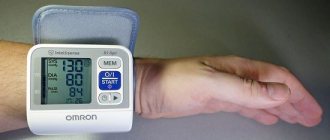A hematoma is an accumulation of blood in the tissues of the human body, and its occurrence is caused by damage due to falls and blows. In some cases, the appearance of a hematoma is not associated with physical effects, but is explained by the presence of a specific disease in a person.
In most situations (this applies to small hematomas), serious consequences do not occur, and the inflammation itself disappears after some time. However, there are often cases that require medical consultation and qualified treatment. Ignoring a bruise can lead to the formation of a cyst or tissue necrosis.
Why it is not recommended to treat a hematoma on the leg at home
If there is large accumulation of blood under the skin, it must be removed. There are enough videos and articles on the Internet describing this procedure at home, but you absolutely cannot follow such advice. Firstly, a person risks damaging his leg even more and disrupting its normal functioning, even to the point of disability. Secondly, and more likely, you can introduce an infection into the body and provoke even greater inflammation. Thirdly, only an experienced doctor using special equipment will do this carefully, but independent attempts can permanently disfigure the skin and leave unaesthetic scars on it.
Bruise, bruise, hematoma, lump. How to say it correctly? Let's learn proper terminology.
In practice, we often encounter cases where a wide variety of terms are used to describe the same injury, which often leads to significant confusion. And the greatest confusion arises when, as a result of some impact (usually traumatic) on the body a person develops intradermal and subcutaneous hemorrhage - bruise.
They just don’t call this kind of damage – a bruise, a hematoma, or just a “bump.” Are these all synonyms?
Let's figure it out.
What is the difference, if any, between the terms hematoma and bruise? Both hematoma and bruise can form either as a result of external mechanical impact or as a result of disease.
A hematoma is a hemorrhage with a violation of tissue integrity and the formation of a cavity filled with blood. Literally translated, hematoma is a blood tumor (from ancient Greek αἷμα - blood + ōma - tumor).
A hematoma is formed due to the rupture of a vessel, followed by hemorrhage, which leads to tissue separation with the formation of a cavity in them.
A hematoma can be located superficially (under the skin or external mucous membranes), or it can also form deep in soft tissues, such as muscles. Rice. Hematoma of the leg
Rice. Subcutaneous hematoma
Rice. Neck hematoma
Formation of hematomas in the walls of organs is possible.
Rice. Nasal septum hematoma
If a hematoma has formed in the cranial cavity, then in relation to where it is located, the following are distinguished: - epidural (extradural) hematoma (located between the bones of the skull and the dura mater) - subdural hematoma (under the dura mater) - subarachnoid hematoma (under the soft mater) membrane) - intracerebral (parenchymal) hematoma (in the substance of the brain).
Rice. Variants of intracranial hematomas.
In newborns, there may often be a birth tumor on the head - a subcutaneous hematoma, which forms during childbirth in the presenting part of the head. This is fine. In adults, such a hemorrhage under the scalp is formed as a result of a blow, and is popularly called . ”
Newborns may also have a cephalohematoma (cephalohematoma) on their head. This is a hematoma, formed during childbirth and located between the periosteum and the outer surface of the cranial bones. The tumor is limited to the edges of one or another bone of the skull.
Rice. Variants of birth trauma to the head of a newborn. A. Cephalohematoma (subperiosteal hematoma). B. Birth tumor (subcutaneous hematoma)
So, an important, significant sign of a hematoma is the formation of a cavity filled with blood. If there is no cavity filled with blood, it is not a hematoma. Bruising is bleeding into soft tissue (for example, skin) while maintaining the tissue structure. A cavity in the tissue does not form during a bruise; this is not a cavity formation.
Rice. Bruise
In unprofessional, everyday speech, a bruise is called a bruise. Bruise is not a medical term, but a colloquial one. Not a single doctor, including a forensic expert, uses the word “bruise.” It is not recommended for lawyers to use this word in their professional activities.
Sometimes, wanting to show knowledge of medical terminology, a bruise is called a hematoma. This is fundamentally wrong. If someone wants to call a bruise in Latin, call it hemorrhagic permeation of the skin.
As a synonym for the word bruise, doctors often use the terms “ecchymoses” and “petechiae.” Ecchymosis is hemorrhage in the skin or mucous membrane, the diameter of which exceeds 3 mm. Petechiae are pinpoint hemorrhages in the skin, mucous membranes, serous membranes and internal organs, up to 3 mm in diameter.
Rice. Multiple petechial hemorrhages (point hemorrhages) in the skin of the arm.
Bruises in the skin change color over time and “bloom,” which allows forensic medicine to determine how long ago they formed.
Bruises in an array of soft tissues are called hemorrhages, for example, hemorrhages in the muscles of the thigh, forearm, etc.
Rice. Hemorrhage into the muscles of the forearm.
So, in this brief review, we tried to find out what the difference is between a bruise and a hematoma.
And knowing this difference is very important, since a bruise and a hematoma are different formations, they have different consequences for the body, the tactics of their treatment are different, and the severity of bodily injuries is different.
Treatment of hematoma on the leg
Typically, a hematoma on the leg after a bruise is treated by two methods: conservative and surgical. The first category includes: cold and warm compresses, pressure bandages, taking analgesics, applying ointment, physiotherapeutic manipulations.
The second group involves performing a puncture - surgical removal of accumulated blood from the site of a bruise with the application of a suture and an aseptic bandage.
Treatment of a serious hematoma on the leg must be carried out under the guidance of a doctor; this will speed up the healing process and prevent unpleasant consequences.
What is a bruise
Almost every one of us first becomes acquainted with these formations on the body in childhood, because there is not a single child in the world who has never fallen or hit something. Therefore, everyone knows what a bruise is. This is a bluish (hence the name) spot that appears at the site of the bruise. If bruises form accidentally in children, then in older people, especially among representatives of the stronger half of humanity, they can “bloom” on the face or other parts of the body as a result of a fight. Among the peaceful part of the adult population, bruises appear from accidental bruises, after injections, intravenous injections, squeezing the skin with great force, pinches or bites, for example, from a pet. In all these cases, small blood vessels rupture in the subcutaneous layer, and blood flows out of the wounds into the resulting cavity. That's what a bruise is.
In the cavity, the blood can be in a liquid state, thickened or already completely coagulated. If an injury causes a rupture of not only blood vessels, but also the skin, the blood flowing from the wound can be seen visually. If the top layer of skin remains intact, it will appear as a bluish or purple bruise.
What does a bruise look like and why does it change color?
A bruise is blood escaping from a vessel. Gradually the blood decomposes and the color of the bruise changes. The red-blue color of a bruise is the color of hemoglobin, the main protein in the blood. All subsequent changes in the color of the bruise are variants of hemoglobin decomposition. The products of hemoglobin destruction are biliverdin (green bile pigment) and bilirubin (yellow-red bile pigment). As hemoglobin breaks down, the bruise changes color from red through purple, cherry and blue to yellow-green and yellow. Then the decay products at the site of the bruise are removed, and the color disappears. The bruise usually goes away completely within 2-3 weeks.
Difference
What is the difference between a hematoma and a bruise? From the above it is clear that both are accumulations in the formed cavities of a large or small amount of blood that has flowed out from ruptured blood vessels. There are several differences between these two concepts.
- The word “bruise” is used colloquially, and “hematoma” in official medicine, criminology, jurisprudence, and scientific literature.
- The medical term hematoma comes from the fusion of two Greek words, ema, meaning blood, and oma, meaning tumor. People called bruises the spots on the skin that appear after bruises or other injuries, because of their characteristic blue with various shades of color.
- A bruise is always visible to the naked eye because it forms in the subcutaneous fat layer. A hematoma can appear not only in the subcutaneous tissue, but also in the internal organs, so sometimes instrumental examination is required to detect it.
- Bruises are commonly called spots that go away without treatment. Hematomas can be so complex that they require mandatory medical intervention.
Symptoms of bruises
When talking about the difference between a hematoma and a bruise, we cannot ignore the symptoms of these formations. Bruises can appear almost immediately after vascular injury. In this case, they are classified as early. Such formations rarely cause health problems. Only when they appear on the face do they cause psychological discomfort in some people. Characteristic features of bruises:
- painless unless touched with great force;
- do not lead to swelling of the injured area;
- do not cause pain when moving.
Sometimes it happens that bruises appear a little later after the injury (one or several days). In this case, they are classified as late or very late. Such bruises are practically no different from early ones, but before their visual appearance, a person may experience pain at the site of injury.
Bruises do not require special treatment, but to prevent them from appearing, you can immediately apply ice to the site of the bruise. An already “blooming” bruise can be lubricated with “Bruise-Off”, “Express-bruise” cream or “Thrombocide” gel so that it resolves faster.
Why do some people bruise more often than others?
Typically, the incidence of bruising increases with age. A slight blow or scratch is enough to cause a bruise in an elderly person, but in children they do not occur with much more severe injuries. This is due to the fact that blood vessels become fragile with age.
Another reason may lie in the medications used that prevent blood clotting. These medications include prescription arthritis medications (non-hormonal anti-inflammatory drugs) such as ibuprofen (Advil, Nupril) or naproxen (Aleve) and over-the-counter medications such as aspirin. Warfarin (Coumadin) is often prescribed to prevent blood clotting in patients suffering from plaque in the blood vessels of the legs or heart. This medication can cause extremely severe bruising. And cortisone-based drugs, for example, Prednisone, increase the fragility of blood vessels. In addition, people with hereditary (hemophilia) or acquired (cirrhosis of the liver) bleeding disorders suffer from bruising, which, among other things, can lead to fatal bleeding.
Classification of hematomas
You will be surprised to know how many types of hematomas exist in official medicine. There are several criteria that determine the differences:
1. According to the state of the exudate and blood that make up the hematoma:
- fresh (the blood in it is liquid);
- organized (blood already coagulated or heavily thickened);
- infected (pathogenic microorganisms have been added to the blood);
- festering.
2. By size:
- small, dotted;
- large (over 3-5 mm in diameter).
Such bruises on the body can be located singly or in groups.
3. By location:
- subcutaneous hematoma;
- subserous (effusion of blood into internal cavities - abdominal, pulmonary);
- intracranial (subdural, epidural);
- intramuscular.
4. According to clinical signs:
- pulsating;
- encysted;
- not pulsating.
We can say that a bruise is a subcutaneous hematoma, not pulsating, large, fresh or organized.
Sometimes hematomas are divided according to the type of damaged vessels:
- arterial;
- venous;
- mixed.
A bruise can appear when the integrity of both small venous vessels (venules) and arterial vessels (capillaries) is damaged.
Symptoms of hematomas
A person can develop a simple superficial hematoma anywhere on the body. Her ICD 10 code is T 14.0. The symptoms of superficial hematomas are the same as those of bruises.
Intramuscular hematomas are almost always very painful. A person has:
- swelling at the site of injury;
- stiffness of movements;
- difficulty or inability to perform certain movements due to pain;
- Sometimes the victim develops a fever.
If a hematoma occurs in the internal organs, pain in this organ, and sometimes in neighboring areas, always comes to the fore. The rest of the symptoms depend on the location of the injury. So, if a hematoma appears in the gastrointestinal tract, nausea and vomiting may occur. If in the lung area, a cough appears (sometimes with blood), difficulty breathing. A hematoma in the brain is accompanied by headache, nausea, sometimes clouding of consciousness and temporary loss of vision.
And a few words about preventing bruises
If bruises occur too easily, you may not have enough Vitamin C. It strengthens the walls of the capillaries, reducing the likelihood of ruptures and hemorrhages. Ascorutin can be recommended from pharmaceuticals, citrus fruits, kiwi, sweet peppers, etc. from products.
Increase your intake of carrots, apricots and citrus fruits that contain bioflavonoids. This will increase the effectiveness of vitamin C in the body. Another good source of bioflavonoids is grape seed extract.
The recommended dose is 20-50 mg daily. A susceptibility to bruising may indicate a deficiency of vitamin K, which is abundant in broccoli, Brussels sprouts and leafy green vegetables. Naturally, ready-made drugs are also sold.










